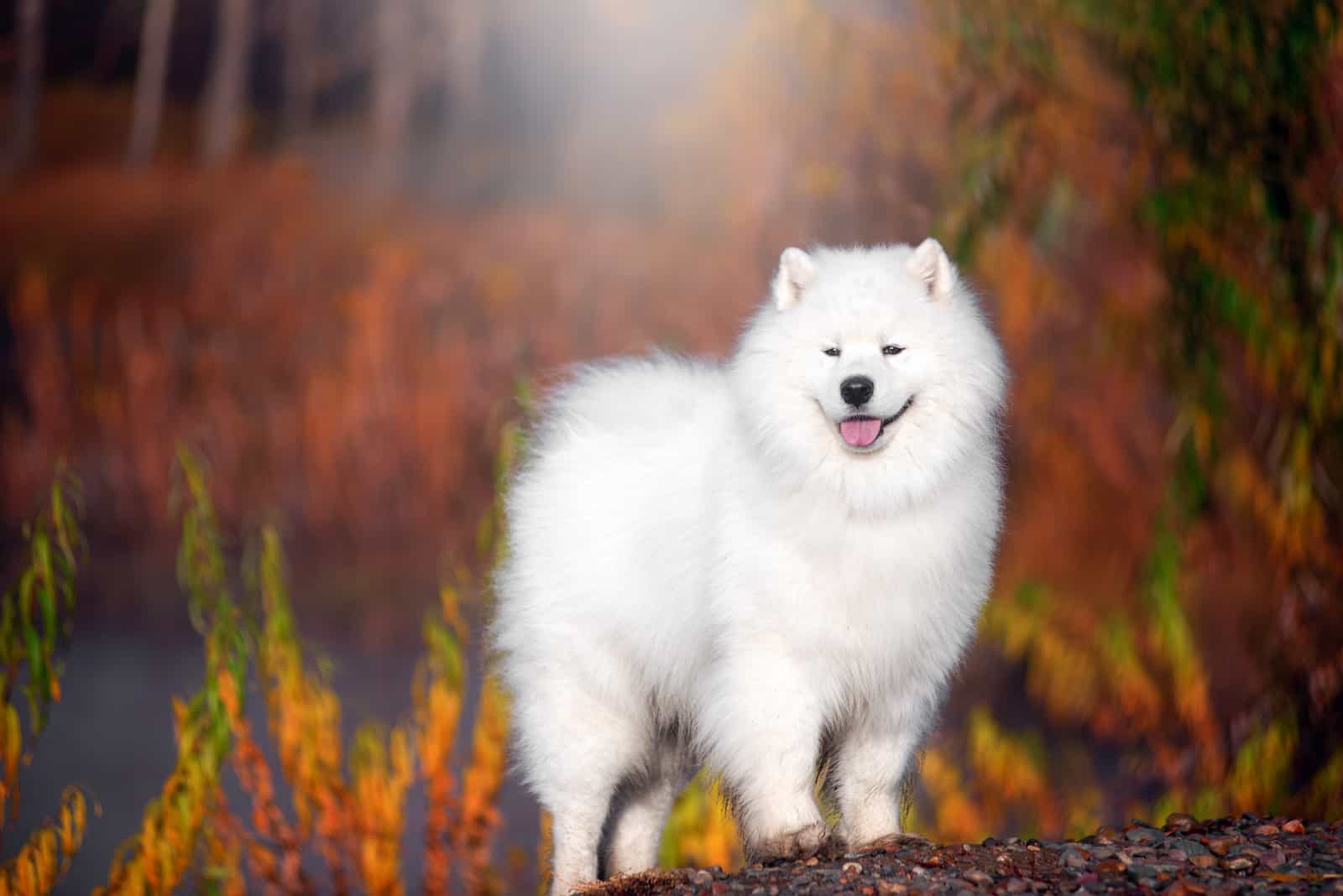As diligent as a Siberian Husky, and as kind as a Golden Retriever, meet one of the sweetest dog breeds in the world, the Samoyed. They may not be as popular as other dog breeds, but I’m noticing a significant rise in their popularity in the past couple of decades.
But, I’m not here to talk to you about how amazing this dog breed is. I’m here to teach you that Samoyeds come in a variety of choices. There are four Samoyed colors you can choose from. All of them resemble each other, with slight differences in terms of color intensity and positioning on the body.
No matter which coat color he fashions, the Samoyed will always be a good family pooch, with the kindest eyes and the most adorable smile.
Without further ado, let’s talk more about Samoyed colors, their coat, maintenance, and the overall impression of the breed.
Let’s walk into this article with a huge Sammy smile on our faces!
The Origin Of The Breed: A Word About Samoyeds
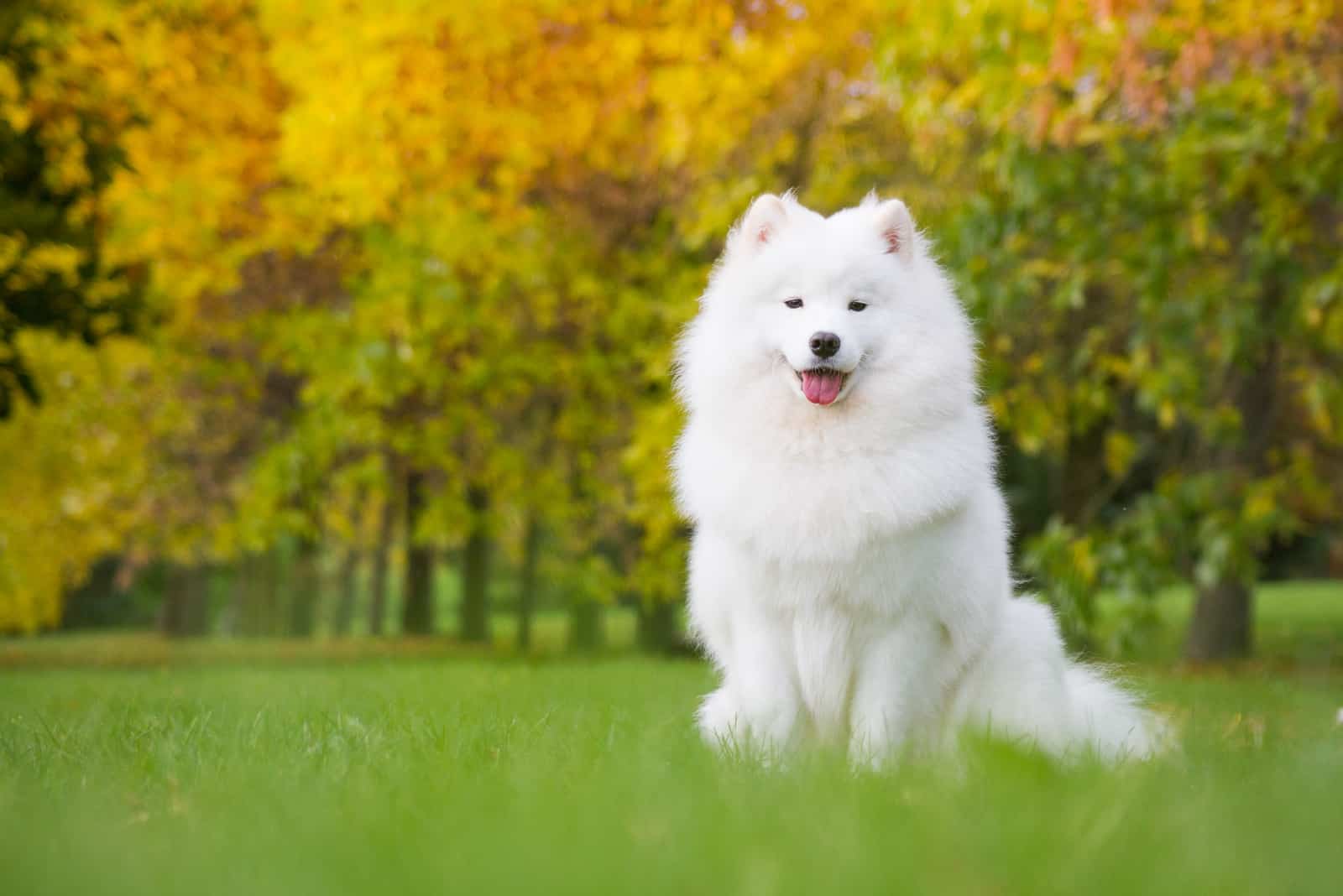
For centuries, Samoyeds have been ruling the great Siberia, a region where snow is all you can see and expect. But, the eternal winter didn’t allow these dogs to lose their happy attitude. A permanent smile stayed glued to their faces, maybe because of the frost, or maybe because they’re predisposed to act joyful.
Samoyeds are one of those dog breeds bred specifically to serve as herding dogs, keeping everyone safe and away from trouble. They were hard workers, pulling sleds and helping during hunting trips on reindeer. Even their name came from the people they used to help – the Samoyede people.
The Samoyed dog has always been a family pup. They’re an affectionate dog breed that loves getting attention all the time. But, they give it in return, too!
The Samoyed breed is truly a delight to own. But, don’t think of getting one if you’re not an active dog owner. With such a rich history of serving as working dogs, today’s Samoyeds are pups with a strong prey drive and high energy levels. They need something to do; otherwise, they’ll feel bored, or maybe even destructive! Engage such dogs into agility courses and you’re good to go.
Even though the Samoyed has origins from the Arctic area of Siberia, that didn’t stop them from visiting Antarctica. Did you know that Samoyeds were one of the dog breeds used in Amundsen’s polar expeditions to the South Pole? Well, now you know!
The world found out about the amazing Samoyed dog breed at the turn of the century, from 19th to 20th. In the early 1920s, Samoyed puppies came to America. Shortly after, the first Samoyed Club of America was founded and the breed stayed for good. I know the States don’t really have the same
Siberian climate, but they seem to like it here. Well, we like having these friendly dogs, too!
Good Looks: The Appearance Of A Samoyed
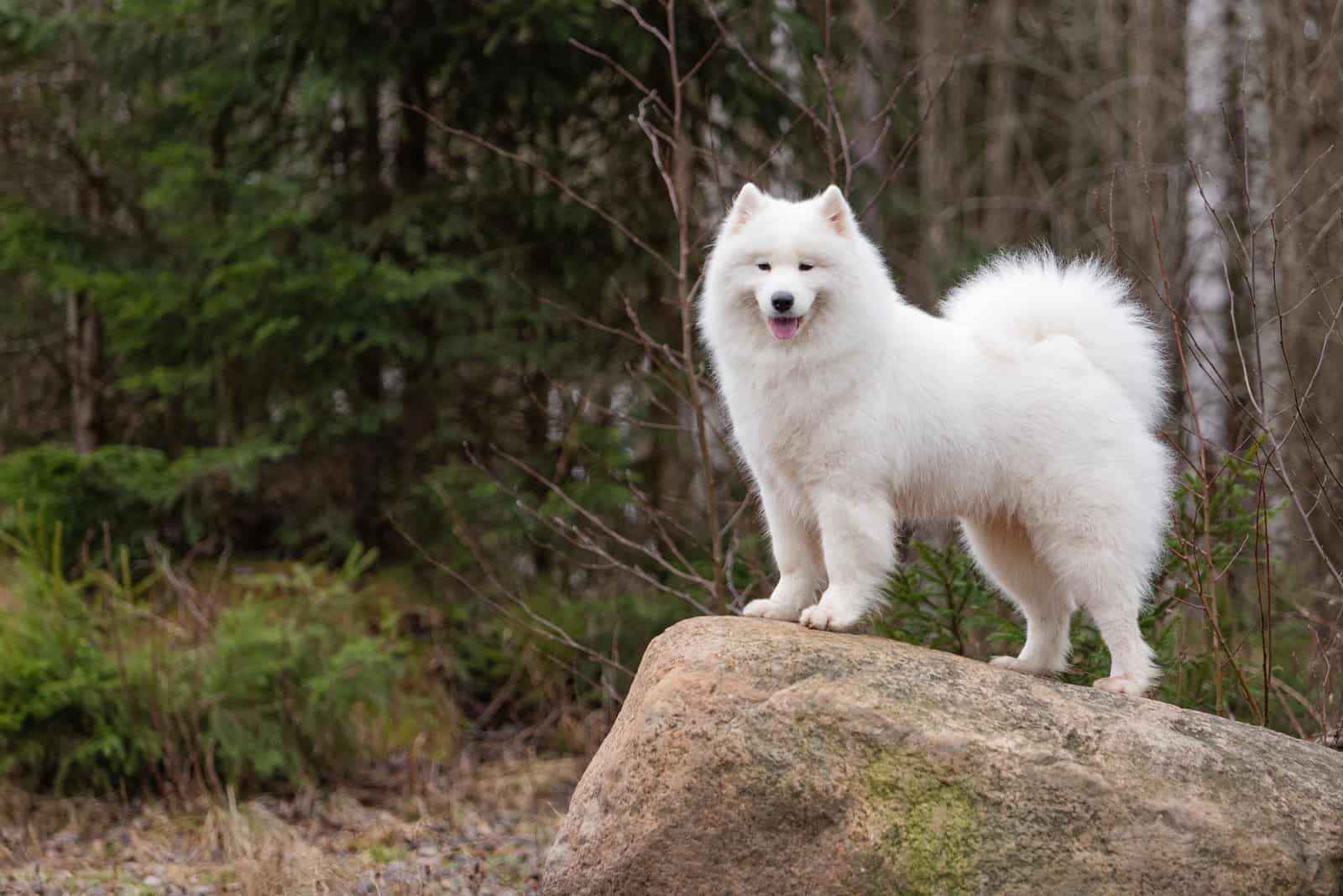
One look at them and you’re sold for life!
Samoyeds are that kind of dog breed that will win you over for good with their permanent Sammy smile and the fluffiest light coat ever. But, let’s talk about some facts that will help you distinguish a Sammie from other Spitz-like dogs on the street.
Samoyeds are medium-sized dogs. They have a rather square build, with a wide head. They’re proportional, and have signature body features like the poofy, curled to the back tail and erect ears.
As their breed standard suggests, male examples of this breed can grow from 21 to 23.5″ at the withers compared to their female counterparts, which are between 19 and 21″. A curiosity of the breed is that both genders weigh the same: 50 to 60 pounds! That’s why it’s so hard to tell which Sammie is a boy and which is a girl. Even their poofy white coat makes it hard!
Which Coat Styles Do Samoyeds Fashion & How Do You Groom Them?
As you can imagine, Samoyeds are dogs with a double coat – an undercoat and an outer coat.
On the outside, their coat is straight, a bit rough, and quite thick. But, the undercoat is a dense layer of softness that helps with the poofy appearance.
Having such a thick coat can only mean one thing: Samoyeds are not hypoallergenic at all!
These dogs shed a lot, especially during spring and fall. That’s why you need to brush them constantly. Okay, maybe not that extensively, but daily brushing is still a must. Outside the great malt season, you can cut down the brushing sessions to three to four times a week.
A Sammie that has not been brushed or trimmed for a couple of weeks looks scruffy and sad. Don’t let that happen to your dog. Make sure you brush regularly, and give a trim as you notice its coat is starting to lose its nice shape.
AKC-Approved Samoyed Colors
The official American Kennel Club approves only the following coat colors. Anything else besides these is considered faulty, non-existent, or a fraud. Trust me, there’s no such thing as a red Samoyed or even a black one!
Focus on the following Samoyed colors:
• White
• Cream
• Biscuit
• White and biscuit
Now, let’s hear something about each coat color. You’ll notice the differences are not that big. Sometimes, cream and white Samoyeds look the same. But, I’ll help you train your eyes and learn to tell them apart.
White Samoyed: Soft As A Cotton Bud
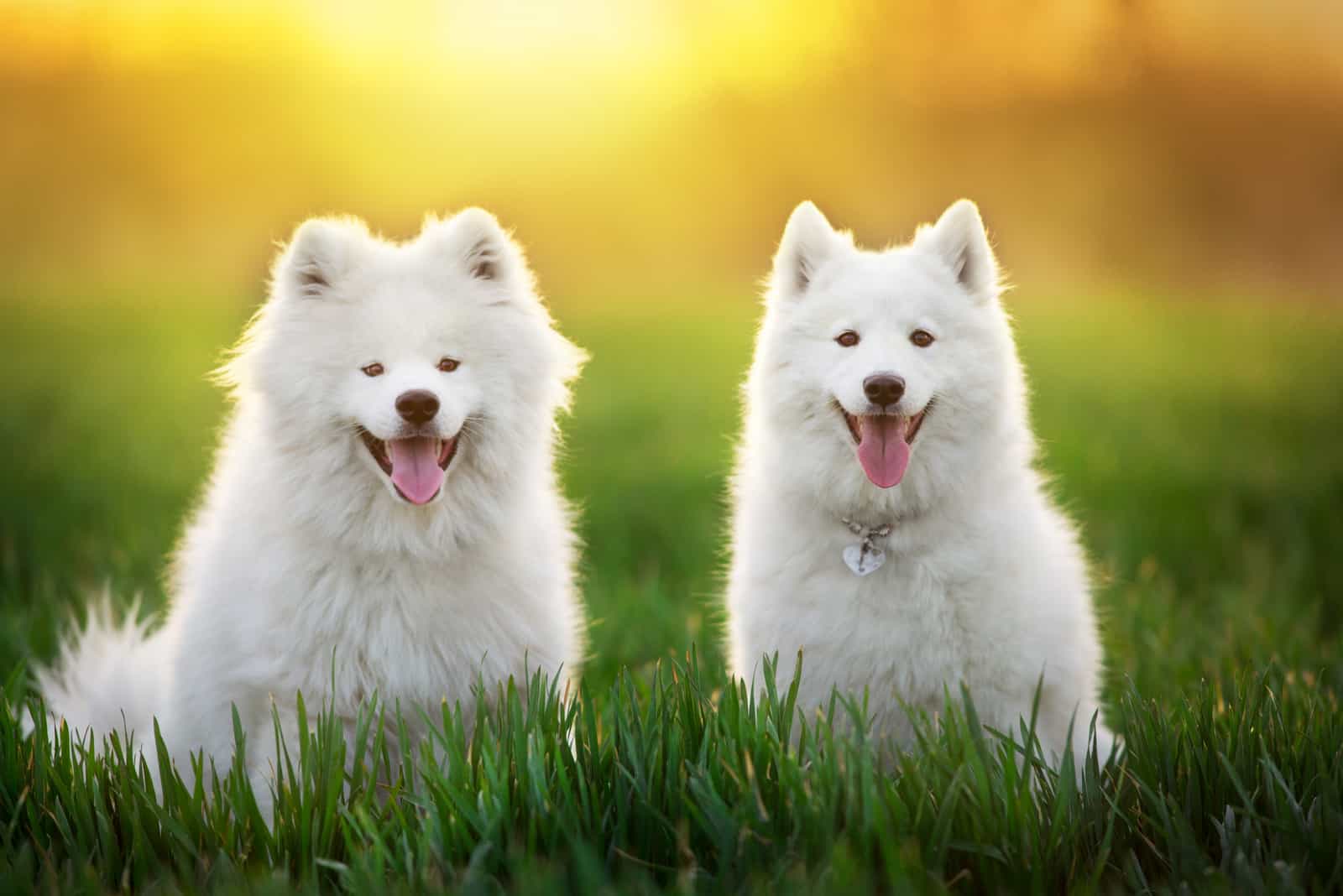
With white being the most common Samoyed color, you should know something: this soft white snowflake was purposely bred to be white.
It all has to do with their origin as snow dogs from Siberia. A completely white or lightly-tanned Samoyed would fit into Siberia’s snow perfectly. A dark-colored one would stand out and be an easy target for enemies and wild animals. That’s why the early Samoyed breeders did their best to breed only white Sammies.
But, not every Sammie gets to keep the all-white fur. Of course, I’m not talking about getting their coat dirty. I’m talking about a change that happens to some Samoyeds. Their coat might become lighter or darker in this case, but they’ll always carry the white coat gene.
What I can’t stress enough is that white Samoyeds aren’t albino dogs! If they were, their eye rims, nose, and lips would be light-colored, and not black or dark brown.
Cream Samoyed: Fluffy & Equally Cute
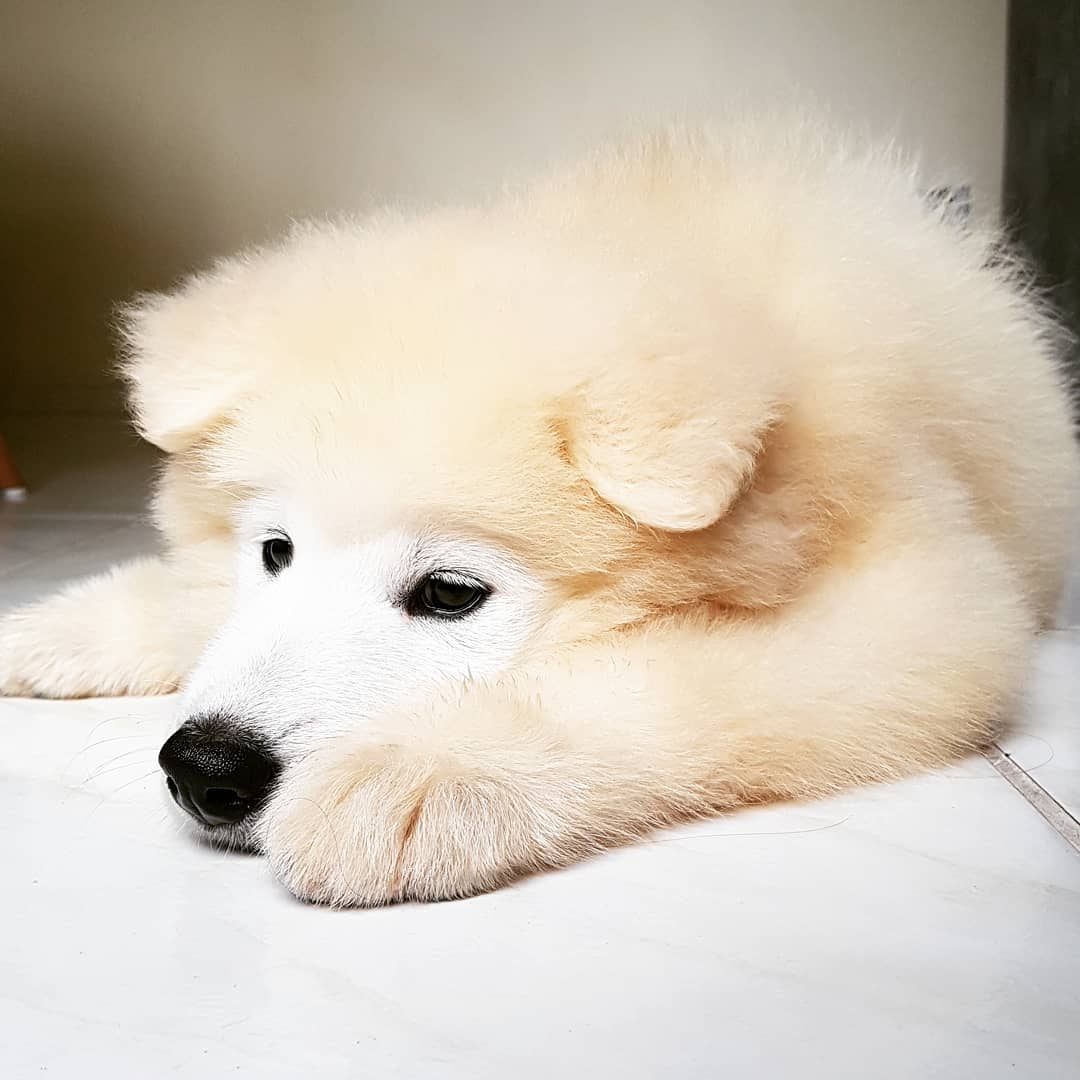
Photo from: @aventurasdeasterix
Cream Samoyeds are as yummy as sweet custard.
No, seriously… their pretty coat markings makes them as sweet as any desert.
A cream Samoyed should have a light tan, slightly yellow coat color. It’s so light in shade that people often mistake it for a white Sammie.
If you’re looking strictly for a cream Sammie, you should know that dark tan shades are not acceptable at all. If you want a purebred cream Samoyed, look for lighter shades only!
Biscuit Samoyed: As Sweet As A Real Biscuit
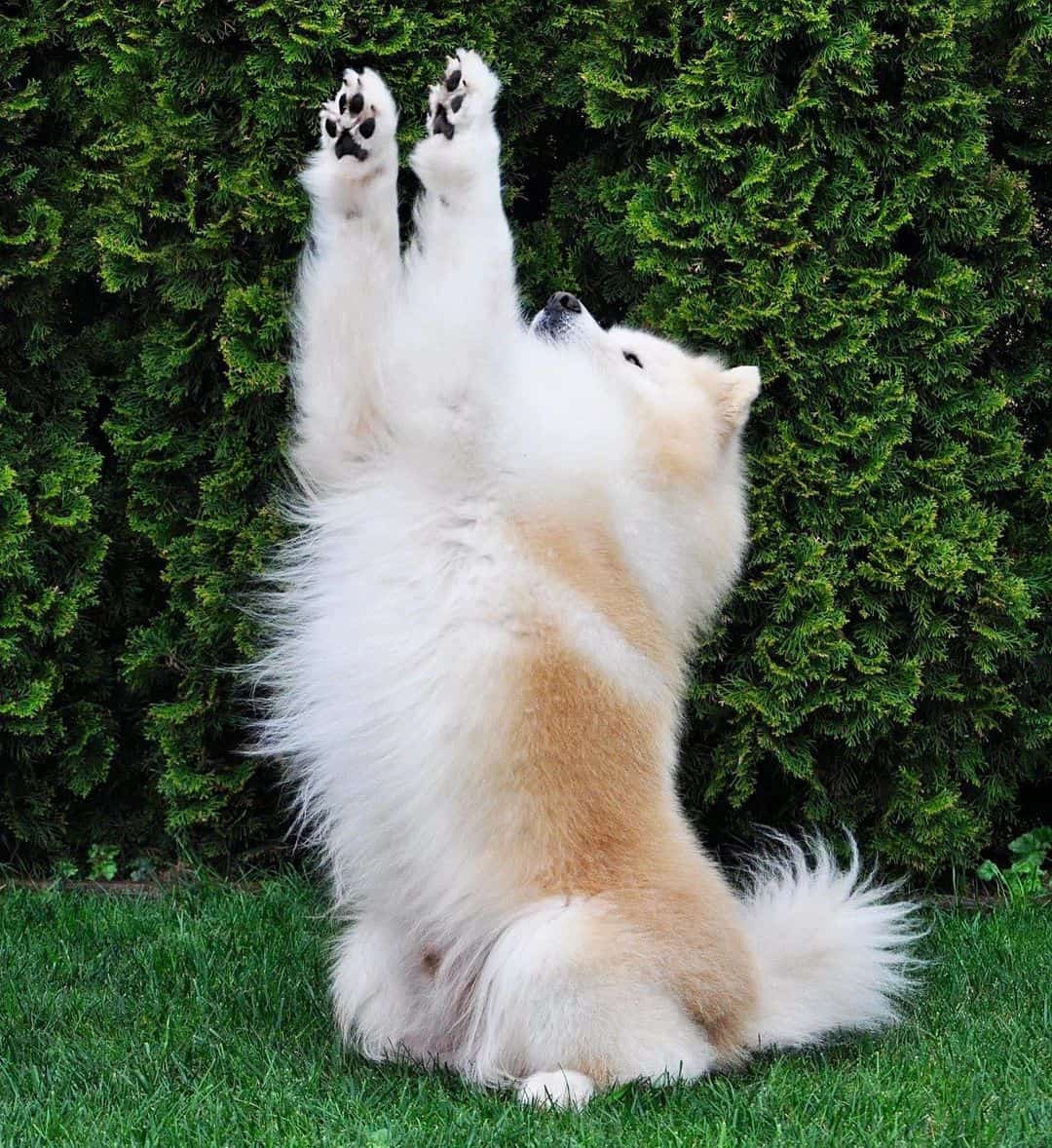
Photo from: @snowystarsamoyeds
Only two dog breeds in the world are fashioning this lovely biscuit coat color. It’s the small, but feisty Pekingese, and our Sammie.
You’ll easily spot an all-biscuit Samoyed. He’s got a medium-shine, brown-golden shade resembling a freshly baked biscuit, *hint, hint*.
These pups have brownish markings all over their body, including their neck, ears, and shoulders. The white coat is visible on their tummy, chest, tail, and leg area.
If a puppy carries a biscuit coat gene, he will turn from all-white to biscuit as he grows up. Curiously, it’s possible the other way around, too! As the biscuit puppy matures, he may or may not turn completely white.
And, that’s why you should never judge a puppy based on its coat color!
White And Biscuit Samoyed
If biscuit Samoyeds are rare, wait until you see the white and biscuit Samoyed!
This pooch fashions a white coat base. It’s covered in brownish-yellowish stains, which add to the uniqueness.
Unfortunately, these medium-dark markings can disappear over time and become quite light. So, if the coat color is very important to you even when the puppy grows up, you should pick the darkest puppy from the litter.
Do Samoyeds Have Rare Coat Colors?
Generally speaking, Samoyeds are not that common on U.S. streets. The biggest reason has to be their price, followed by a late arrival to the States.
A dog breed this rare also has some rare features in terms of their coat color.
To answer your question: yes, Samoyeds can carry a rare coat color! For this dog breed, it’s the biscuit color that’s considered rare.
As you can imagine, biscuit Samoyeds are quite pricey and hard to find. Good luck pursuing one!
Does A Samoyed’s Coat Color Affect Its Health?
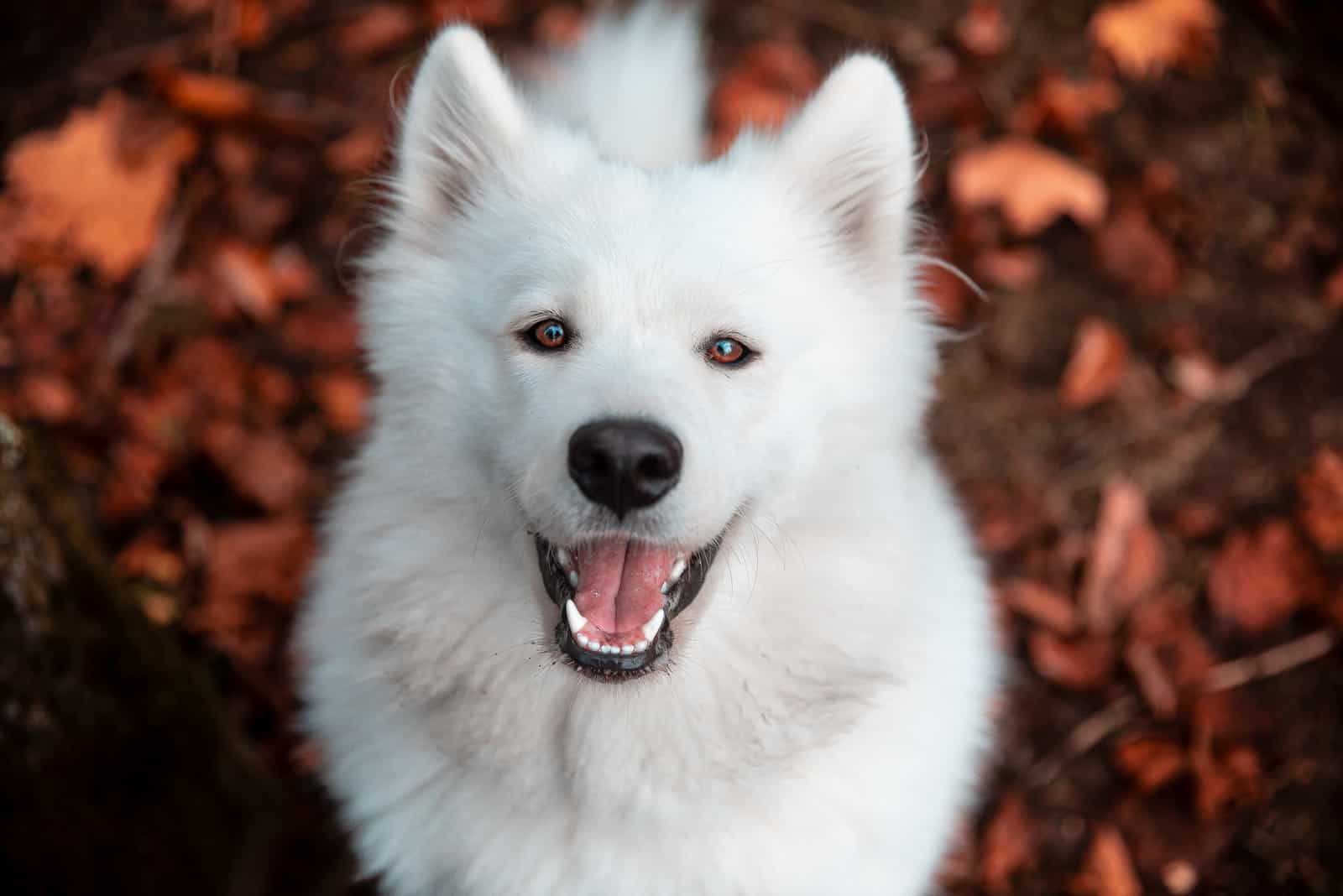
Many breeds of dogs with an all-white coat have numerous health issues related to their vision or skin condition. However, those dogs are albino dogs. It’s the messy work of the genetics that’s causing their health problems.
Luckily, pure white dogs don’t necessarily mean albino. The Samoyed is a good example. The truth is a white Samoyed is as far from color-related diseases as a black and tan German Shepherd.
White is only their coat color; it’s not a result of insufficient pigmentation. Samoyeds have dark markings on their nose, lips, and eye rims, making them perfectly normal. This is proof that they have pigment!
To answer this very important question: no, a coat color doesn’t affect a Sammy’s health. It doesn’t even affect its behavior. Their coat color is only what it says it is: just a color.
However, Samoyeds do have some severe health problems that affect their lifespan greatly.
As a future Sammy owner, you should be aware of the following conditions:
• Hip dysplasia
• Aortic stenosis
• Progressive retinal atrophy or PRA
• Diabetes
• Hereditary glomerulopathy
• Hypothyroidism
• Glaucoma
• Patellar luxation
I’m about to go through all of the listed diseases to help you get a general idea of how severe each one is. Don’t worry… Samoyeds are generally healthy dogs. Just because one suffers from hypothyroidism doesn’t mean your Sammie will, too.
First off, let’s talk about hip dysplasia. Hip dysplasia is quite a common condition that strikes many dog breeds of all sizes. Samoyeds are just one of them. This is a genetic condition that can be transferred from a parent down to a puppy. The condition occurs when the thigh bone doesn’t fit snugly into its designated hip joint. This causes extreme pain, and may even lead to serious mobility problems. Hip dysplasia is the first step to senior arthritis. Samoyed puppies carrying this illness shouldn’t be bred further. Always ask your breeder for 100% clean hip certifications.
Pulmonic stenosis and aortic stenosis are heart conditions characterized by narrow valves.
Progressive Retinal Atrophy, or PRA, is an eye condition that every breeder must test for. If a puppy is a carrier of this disease, it shouldn’t be sold or bred further. PRA starts with limited sight, but progresses into night blindness and total blindness if not treated correctly.
Sadly, I see many dogs these days suffering from diabetes. This life-endangering condition occurs when the body can’t control sugar levels in the dog’s blood. Dogs with diabetes are always thirsty and hungry. But, they don’t gain weight. In fact, they lose it! To control diabetes, your Samoyed will need appropriate dog food and insulin.
Hereditary glomerulopathy is a dog disease striking the kidneys. It’s rather serious, especially for males. The good news is that it can be discovered early. The bad news is there’s still no testing for it.
Hypothyroidism means a slowed down or a fast pace of a dog’s thyroid gland. You can easily spot a dog with thyroid issues. He’s lethargic, maybe obese, has some hyperpigmentations, and in severe cases, suffers from epilepsy.
Glaucoma is another health condition that can be passed on from the parents to a baby Samoyed. Glaucoma is painful, and may even lead to vision loss. Luckily, it’s operable if discovered in time!
Lastly, we have patellar luxation. This crippling disease of the kneecap happens when the knee joint doesn’t stay put in its place. Patellar luxation is something that will cause your dog tremendous walking pain if not treated.
Now that you know all the possible health issues of the Samoyed breed, you should also know a few other things.
When choosing a dog breeder, you should always ask for one that’s a member of the CHIC. This abbreviation stands for the Canine Health Information Center program. This means you can ask your breeder to see your pup’s screening results for hip, bone, and eye diseases. If your Samoyed carries OFA, PennHIP, CERF, and OFA testing results with brilliant scores, you’re safe to buy.
If you do find a breeder who doesn’t want to show you an OFA certificate or some other certificate, run! You shouldn’t trust that breeder with your money. Look only for reliable guys who will help you find the ideal Samoyed puppy.
Do Black Samoyeds Exist?
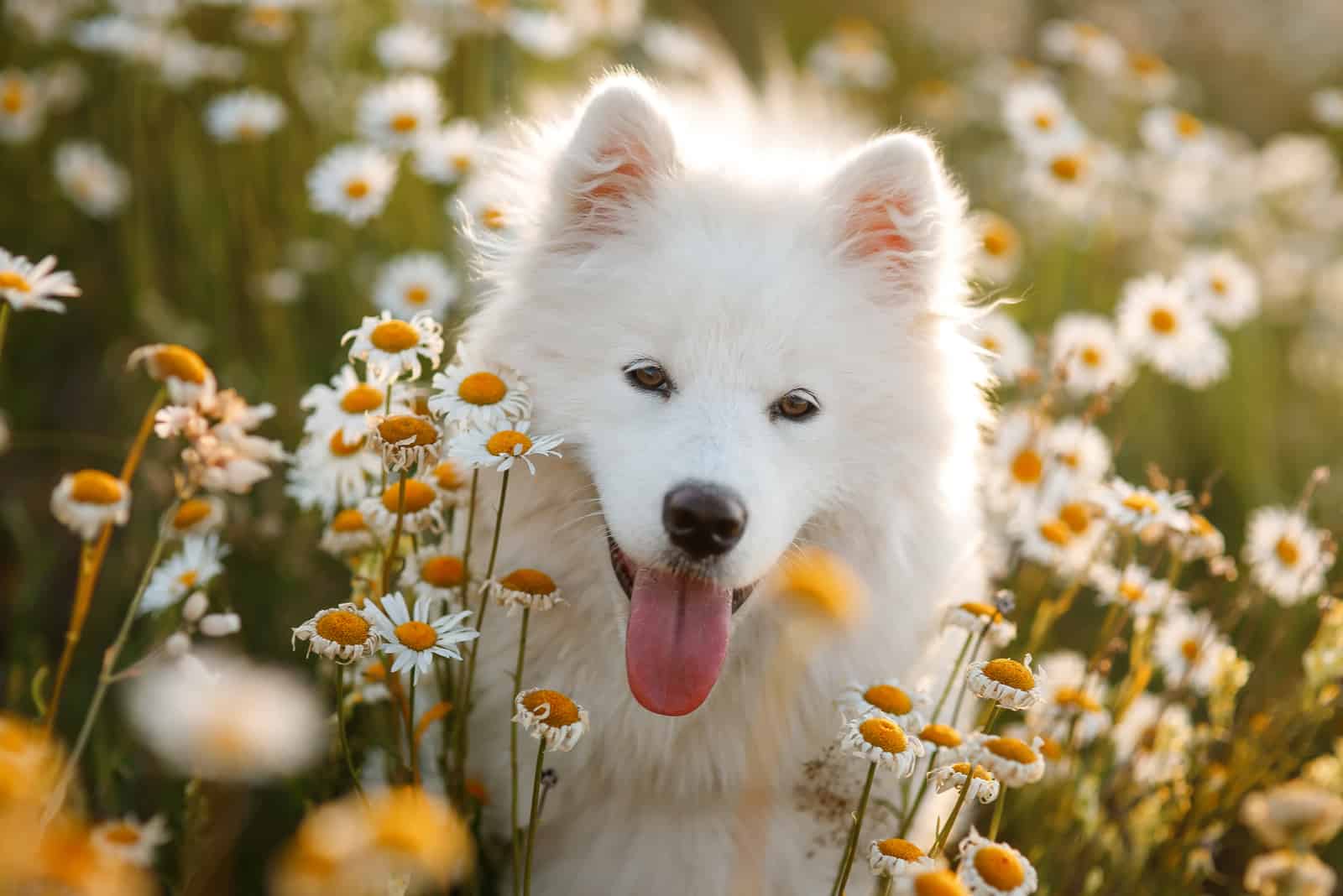
I know black Samoyed pups would be simply to die for, but I’m gonna have to disappoint you. There’s no such thing as black Samoyeds. You’re either looking at the wrong dog breed, a photoshopped picture, or a fraud.
If a breeder is trying to convince you he’s breeding a purebred black Samoyed, just walk away. Don’t even dignify him with a laugh. Black Samoyeds aren’t the real deal. You see, Samoyeds are bred in a way as to always carry a light-colored coat. That’s because these dogs needed to blend in with their white surroundings.
Blue Eyes & A White Coat: Is It Possible?
Yes, blue eyes and a white coat is very possible, but it doesn’t mean it’s right. Many dog breeds face health issues linked to blue eyes.
But, having blue eyes with such a light coat like a Samoyed’s is not acceptable by official clubs at all. It’s considered a serious fault and shouldn’t be encouraged for further breeding.
Samoyeds should always come in light coats and with dark eyes.
What Are The Accepted Samoyed Colors Of The Eye Rims, Nose, And Lips?
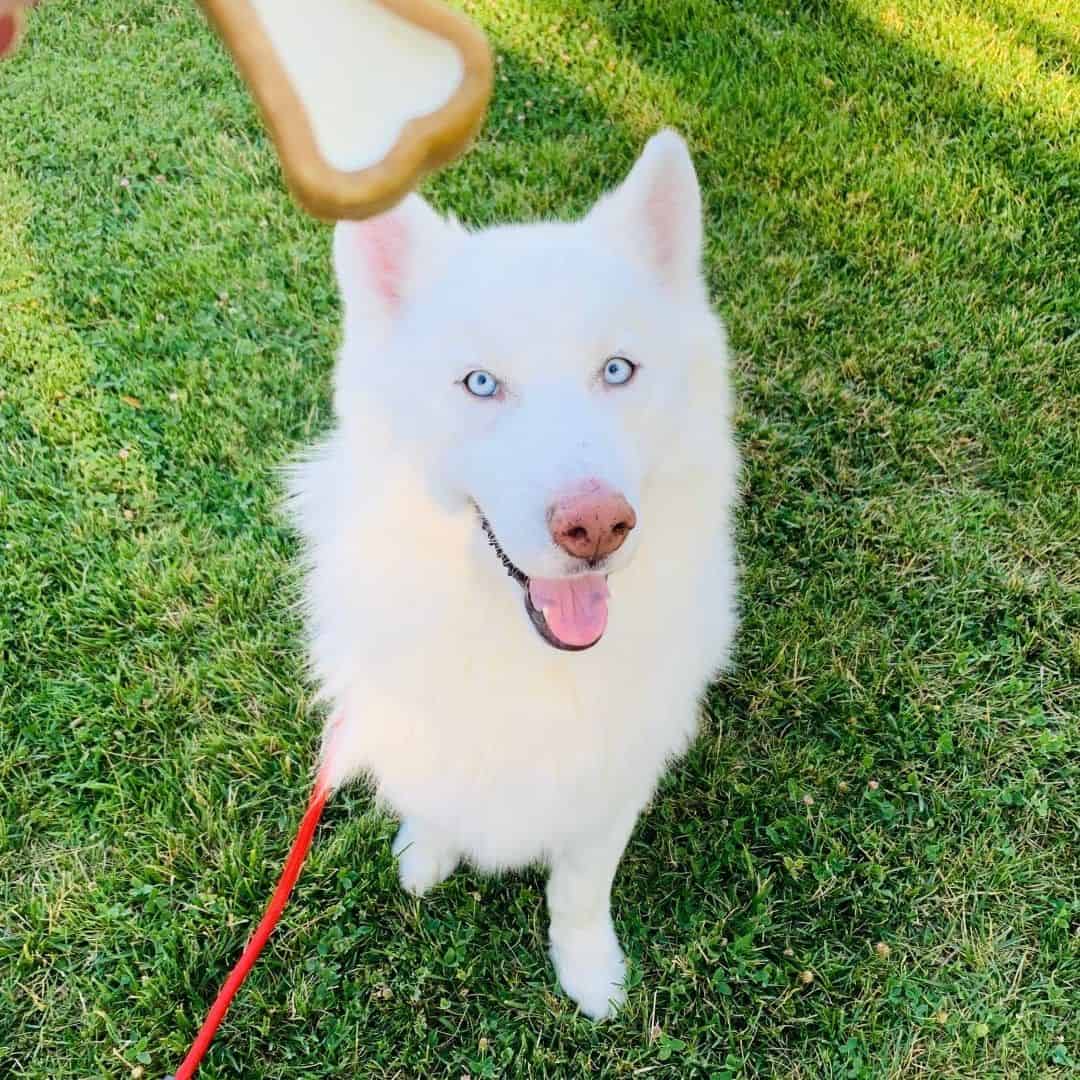
Photo from: @galdamezpuppies
We dog owners accept every color of a Sammy’s points. But, the official clubs don’t.
When I say “official clubs”, I mean the AKC, the CKC, the UKC, and the FCI. Google them if you’re not familiar with these abbreviations, but I’m sure every dog lover knows what they stand for.
Anyway, these official clubs all agree that the Samoyed’s almond shaped eyes should be either black or dark brown. The eye rims are supposed to be in the matching color. However, blue eyes are severely faulty! In other words, no official club will accept a Samoyed with blue eyes. Some clubs even say no to yellow eyes!
As for their nose, Samoyeds can have a brown, liver, or Dudley-colored nose. They are not penalized, but they’re not preferred either. Dog experts agree that Sammies with a black nose are the ideal ones.
Sparkling Clean: Keeping That All-White Fur Really White
Owning a white dog is a bit problematic. They will get dirty, even if they don’t roll in dirt. White dogs are surely a sight for sore eyes. But, scruff-looking, dirty Samoyeds are painful to look at. That’s why I have some tricks for you that will keep that white fur as crispy white as snow.
For starters, did you know that the sun can change a dog’s coat color and make it appear more yellow? For dogs that were designed to live surrounded by the color white, snow is the enemy. Siberian Samoyeds rarely get any sun; that’s why you should keep them away from sources of extreme light.
Dog grooming brands have come up with whitening shampoos designed specially for white dogs. They’re safe to use and mild to your dog’s skin. What you can do is enrich them with baking soda from time to time. But, I wouldn’t overdo it!
All-white dogs often have tear stains in terrible brown-red shades. That’s why you should buy a stain remover that will keep your puppy’s coat white and free from any infection.
Keeping a white Samoyed sparkling white is a bit of a process. But, the biggest advice I can give you is: don’t allow your dog into a muddy park.
Do Samoyeds Shed?
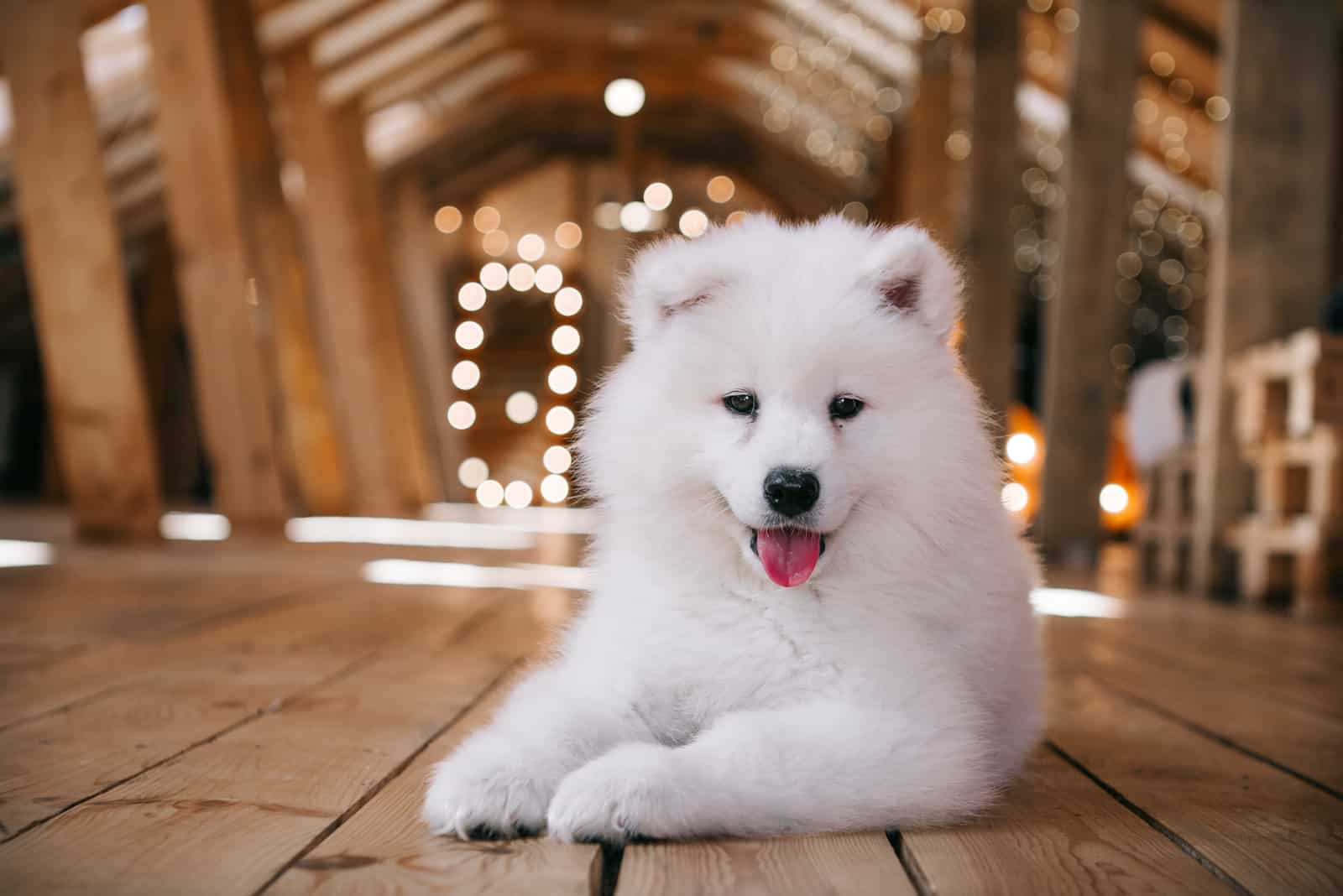
Oh, yes they do!
Samoyeds are double-coated dogs, and it’s natural for them to shed a lot. All of the dead hair gets trapped under the outer coat, requiring your action. You need to brush your pooch regularly and have strong nerves when the shedding season kicks in.
As you can figure out yourself, Samoyeds are not the right dogs for people prone to allergies. Hypoallergenic? Absolutely not!
Which Is The Best Of The Samoyed Colors?
While most people will say that white Samoyeds are the best ones of all the Samoyed colors, I wouldn’t agree. All Samoyed colors are equally terrific! Unlike many other dog breeds, i.e., the Poodle, Samoyeds come in only a handful of colors. And, all of them are beautiful!
However, your dog can fashion the prettiest color on paper, but the practice may be different. If you don’t take good care of your dog, then he’ll have a sad-looking coat. Samoyeds need grooming as much as they need air! If you can’t trim their hair regularly, have a professional groomer do it for you.
In case you do want to groom on your own, I suggest you search the Internet for top-notch pin brushes, undercoat rakes, and combs. These are the most useful grooming gadgets you should own. Grooming is not that hard, but it’s very time-consuming. But, think of it as an occasion to bond with your puppy. Oh, and start early! Once the puppy gets used to the idea of being groomed, he’ll always like it.
Samoyeds are amazing family dogs that are not prone to aggression. If you’re looking for a pup that is 3 in 1: a guard dog, a watchdog, and a companion dog, you’re in the right place.
You won’t find a sweeter smile or prettier coat colors than Samoyed colors!
Read Next: 5 Samoyed Breeders In The UK: Best Sammies Of The Kingdom
